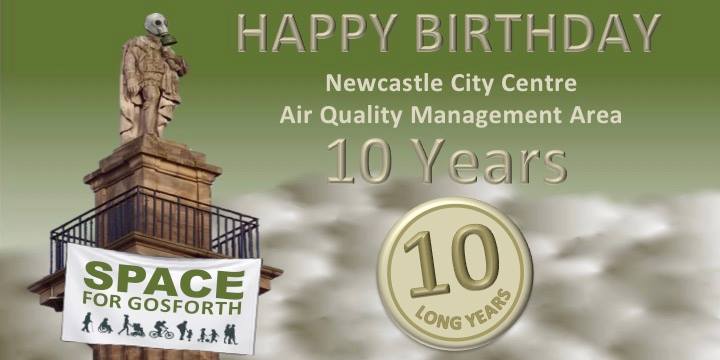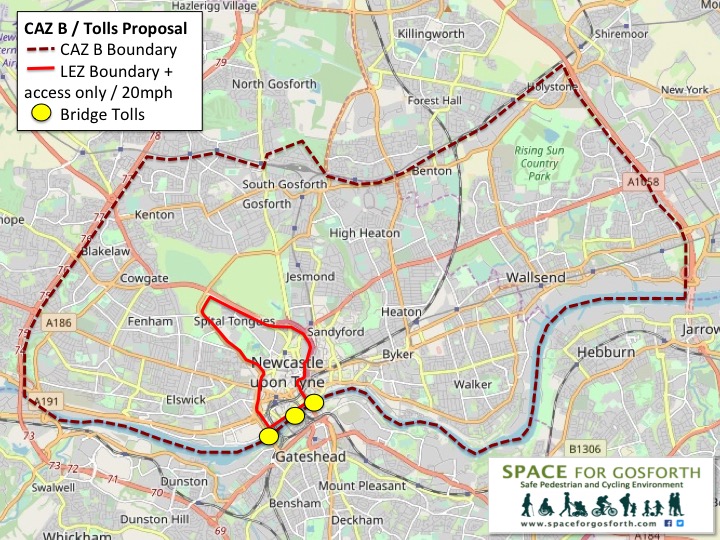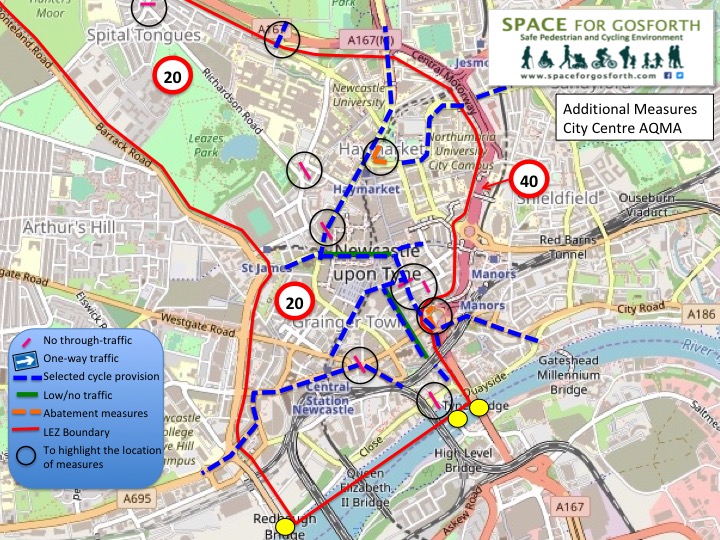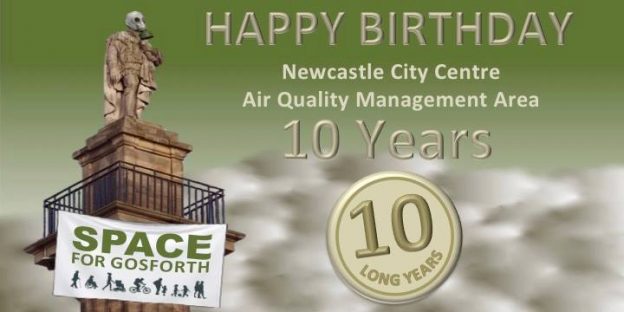
This is the second of four SPACE for Gosforth blogs that together make up our response to the Council’s Clean Air consultation.
Our first blog set out our review of the Council’s proposed measures including a charging clean air zone and an alternative approach made up of a lower emission zone where non-compliant vehicles are banned and there are tolls on the city centre bridge.
In this blog we propose measures for the city as a whole and specifically for the City Centre Air Quality Management Area (AQMA).
The approach we have taken is to adapt the Council’s proposals with the aim of reducing exposure to pollution and achieving compliance with limits as quickly as possible. As we said in our review of the Council’s proposals, we do not believe the proposals as presented meet this legal requirement.
We have also prioritised, where possible, engineering measures rather than charging. These are similar to the city of Ghent’s circulation plan, which led to a 20% improvement in air quality and has also been shown to be beneficial for the city’s economy.
Other measures are based on our review of what works to reduce air pollution.
SPACE for Gosforth response to the Council’s Clean Air consultation: Part 2
Re: Achieving compliance with legal limits for nitrogen dioxide
In this response, SPACE for Gosforth has completed a comprehensive review of the Council’s proposals. We propose additional measures, using local knowledge and the best evidence available to us, to assist the Council in meeting its objectives. These measures include:
- A variant of the Council’s proposed LEZ and tolls
- A wider Clean Air Zone covering the area between the Metro line in the north and the Tyne
- Specific measures in the city centre and Gosforth to reduce traffic and enable alternatives
- Measures that can be implemented quickly to reduce exposure prior to the implementation of a CAZ or LEZ
- Suggestions for management of the implementation to make compliance by 2021 the most likely outcome
Where possible we have tried to avoid charging, but also recognise that measures not supported by some sort of restriction or financial incentive are unlikely to be effective.
We believe the SPACE for Gosforth proposals would be likely to achieve compliance by 2021, and would reduce exposure more quickly than the measures proposed by the Council.
SPACE for Gosforth proposals to meet air quality limits
The plans proposed by the Council have a number of issues that need addressing:
- Not achieving compliance until 2023, where the requirement is to be compliant as soon as possible.
- Issues relating to the CAZ / LEZ boundary including traffic diverted onto residential streets.
- Optimism bias in the modelling, in particular in relation to bus, HGV and taxi compliance.
- Potential adverse consequences as a result of the charge level required for a CAZ D to achieve air quality limits.
- A risk, for the LEZ scenario, that measures will not meet limits or reduce exposure sufficiently quickly on Gosforth High Street and the Coast Road.
- A risk that diverted traffic will increase pollution in areas bordering the CAZ / LEZ.
- Issues with fairness, in that all diesel and petrol vehicles pollute but that the measures don’t reflect that or the level to which they pollute.
- A lack of measures to reduce exposure quickly in advance of a CAZ or LEZ being implemented.
SPACE for Gosforth wishes to propose measures to address these issues, which we believe could achieve full compliance in 2021. On that basis, we don’t believe it would be lawful for the Council to propose a plan where compliance would only be achieved in 2022 or 2023.
For convenience, we have grouped these measures into those that affect the city as a whole (listed below), those affecting Newcastle City Centre (in section 6) and those affecting the Gosforth AQMA (in section 7). We have selected measures as far as possible based on our review of evidence for what types of measure will be effective (see Appendix B).
Many of the measures can be implemented very quickly to reduce exposure prior to the compliance date. In section 10 we have set out some proposals for implementation and monitoring. To save time we suggest, where possible, that measures are initially implemented on a temporary basis then adjusted as the actual impact becomes know, rather than relying on further time-consuming and potentially inaccurate modelling.
What we are unable to do, without having the resources available to us that the Council has, is to optimise the plan for cost to meet the Government’s value for money test. So, while we are reasonably confident of the overall effect, it might be possible to achieve the same outcomes for a lower cost.
Measures proposed citywide are as follows. Target dates are estimates based on what we have seen in other cities and are set to be challenging but achievable if the Council and Government do not introduce any further delays and work to implement measures starts as quickly as possible.
Citywide Measures and Target dates for completion
A01 Public information about and better enforcement of anti- idling laws. Share messages about air quality via variable message signs to encourage people to walk, cycle or take public transport. By 09/2019
A02 High frequency bus route branding introduced to be similar to the Metro as a way of attracting new people to use the bus. To apply to routes with 5 or 10 minute frequency. By 11/2019
A03 Implement emissions-based charging for use of the Haymarket bus station in advance of A06 below. By 01/2020
A04 Implement a taxi exemption scheme that give registered taxis access to through routes in the city centre where drivers have given a commitment to no idling, have completed low-emission driving training and support air quality monitoring set out in measure D08. Such a scheme could also include commitments not to exceed speed limits, no pavement parking and cycle awareness training. By 01/2020
A05 Retrofit bus engines to be EURO VI compliant for all buses that pass through the CAZ B in A06 below. This will result in lower emissions per bus.
Our expectation is that this will only be achieved in the shortest possible timescales if Government commits funding. By 08/2020
A06 Implement a CAZ B for buses, coaches, HGVs and taxis with area bounded by The Tyne, the A1, the Metro line and the A19, and also including Garden Village. We believe this is likely to be sufficient alongside other measures proposed but if not the Council could consider making this a CAZ C or CAZ D. By 08/2020
A07 Implement toll charges on the Tyne Bridge, Redheugh Bridge and the Swing Bridge as per the Council’s proposal. Toll prices set to achieve compliance in first full calendar year. By 08/2020
A08 LEZ for buses, coaches, HGVs and taxis but covering the Urban Core (Newcastle city centre and Spital Tongues) rather than the Council’s proposal. By 12/2020
The CAZ B (measure A06) and LEZ (measure A08) areas are shown in Figure 3 below. These areas are defined in accordance with the good practice set out in the Government’s Air Quality Plan (Annex F).

Figure 3 – SPACE for Gosforth proposals for a CAZ B / LEZ
The CAZ B boundary is the smallest area that meets the Government’s criteria for boundaries and includes within it both the Gosforth and city centre AQMAs. Further measures to apply inside the LEZ are set out in section 6 including the removal of through traffic (other than buses and taxis) and the application of a 20mph speed limit.
As well as resolving issues relating to the boundary of the LEZ / CAZ this also mitigates the risk that areas outside the zone will see increased pollution and will help to achieve limits on Gosforth High Street, at Haddricks Mill and along the Coast Road.
The Council’s Strategic Case explains that the ‘Outer’ CAZ, which covered the same area as the CAZ B above plus North Gosforth, Forest Hall, Killingworth and part of Gateshead, was unlikely to lead to air quality compliance by itself. The Council does not explain which areas specifically remained above the limit in its modelling but our expectation is that the Tyne bridges and CME were likely to be the main locations because of the high traffic volumes. For that reason we believe bridge tolls will also be required.
In ClientEarth v Secretary of State for the Environment Food and Rural Affairs (Case No: CO/1508/2016), the Government’s QC explained that charges would be set at a level to ensure compliance. While we are unable to judge what that level should be we can propose a structure that might better reflect the impact on air quality of each vehicle using the bridges.

With this approach, vehicles would have to be registered with the Council’s payment system to receive any of the discounts. The example charges are set so that lower emission vehicles pay less, but also recognising that even electric vehicles are the source of some emissions through brake and tyre wear.
Different charges might apply for HGVs, buses and coaches. For taxis we suggest a small discount for taxis signed up to the exemption scheme described above. Given taxis pollute just as much if not more than a private vehicle we don’t see any reason for a complete exemption.
Additional measures for the City Centre AQMA
The measures set out above address a number of the sources of air pollution in the city centre. Specifically:
- Cleaner buses will help address air pollution in most city centre locations but especially around Percy Street, John Dobson Street, Market Street, New Bridge Street and Grainger Street.
- The bridge tolls will reduce traffic levels on the main roads around the city centre and may reduce traffic heading into the city. That might reappear though in the form of other traffic heading into the city from the north, west or east.
- Cleaner taxis will help, especially around Central Station.
That still leaves a number of locations, including Percy Street and the Central Station where the Council’s modelling said even a £12.50 daily charge on older private vehicles would not achieve air quality limits. Additional measures are therefore required for these locations.
Figure 4 sets out the main measures we are proposing including the introduction of a consistent 20mph speed limit everywhere within the urban core area (marked by the updated LEZ boundary), a 40mph limit on the Central Motorway, removing through-routes for private vehicles and specific abatement including at Haymarket and by Swan House roundabout.
To determine what approach to use, we have considered what types of traffic are present in each location and what priority should be placed on each. For Percy Street, for example, traffic will mainly be a mix of:
- Buses
- Service vehicles and deliveries to Eldon Square
- Private vehicles parking in Eldon Square and Eldon Gardens car park
- Click and collect traffic
- Taxis
- Private cars travelling through north-bound but not stopping
- Cycling
Air quality measures will not be effective if their effect only changes the mix of traffic rather than to reduce overall traffic levels. For example, if through traffic is stopped but is replaced by vehicles queuing to park, that might actually increase pollution levels overall.
We have also drawn out a basic cycle network structure as a starting point that can be built on when future funding becomes available. This is to ensure that cycling into the city is possible via traffic-free routes from all directions, and that it is possible to access destinations around the city once there. Additional routes to Science Central and the west of the city will also need to be provided.

Figure 4 – SPACE for Gosforth proposals for the City Centre AQMA
A large part of the traffic across the city centre is there to visit rather than to pass through. Asking non- stopping traffic to use the ring road instead (Council policy UC9) is not unreasonable and will help reduce traffic levels and pollution inside the ring road. It is also low cost, quick to implement and will reduce traffic queues and potentially create space for wider pavements or cycle facilities.
Measures also need to be considered for visiting traffic, so that it doesn’t grow to take the space vacated by through-traffic. This can be managed through the use of parking restrictions and fees. The right level for parking charges would have to be determined but this is something that can be monitored monthly with tweaks made at relatively short notice to ensure compliance with air quality limits.
Pricing on-street parking to encourage people to use the major car parks can reduce traffic circulating to look for on-street parking spaces. Best practice suggests that pricing should aim to have at least 20% of on- street spaces free at any given time so that people who need it can easily find a space to park.
More details of the SPACE for Gosforth proposals for the city centre are included in the table below. Most urgently we are asking the Council to revisit the Percy Street proposals that are designed to enable large volumes of through traffic, and where people cycling are expected to share the road with cars, buses and lorries.
B01 Pause and review Percy Street plans. Re-plan based on lower vehicle volumes and look for opportunities to improve facilities for active travel (walking and cycling). By 06/2019
B02 Monthly Clean Air Days – Blackett St in 2019 prior to full bus loop implementation (measure B10). By 08/2019
B03 Remove on-street parking on Grey Street. By 09/2019
B04 Ban the use of portable diesel generators within the City Centre AQMA. By 09/2019
B05 Increase parking charges at Eldon Square / Eldon Garden car parks, including Alive After 5, set to a level so there is no queuing and air quality limits are met. By 10/2019
B06 Any remaining on-street parking charges set to target 20% spaces being free at peak times, to reduce circulation looking for spaces. Fees should be higher than for off-street parking to encourage people to use main car parks. By 10/2019
B07 Install hedges to reduce exposure, especially at Haymarket, Central station, the Swan house roundabout and Coast Road. By 10/2019
B08 Remove through traffic from the Urban Core as per Council Policy UC9, with exemptions for buses. Suggested locations are marked on figure 4. By 01/2020
B09 Taxi exemptions from measure B08 for EURO VI compliant taxis that also commit to and comply with a new Taxi Driving quality standard described in measure A04. By 01/2020
B10 Implement the City Centre “bus loop” to remove all traffic from Blackett Street (except cycles). By 01/2020
B11 A new free-to-use city centre low/zero-emission shuttle bus connecting key locations but especially Central Station, Haymarket Bus Station and the RVI. By 01/2020
B12 Implement a taxi ban on Grainger Street. By01/2020
B13 All roads within the Urban Core set to 20mph. By 01/2020
B14 Lower the speed limit on the Central Motorway to 40mph. By 01/2020
B15 Cycling improvements especially to connect with the Tyne Bridge, Quayside and roads west of the city, and to improve access to Central Station. Initially, for speed of implementation, these can be completed with temporary ‘bolt-down’ kerbs to give protection from traffic. By 03/2020
These proposals should be positive for buses, taxis and cycling:
- For buses, less traffic should mean fewer delays in the city centre. Increased parking fees and the bridge tolls also make buses more attractive compared to private vehicles so should encourage greater use.
- Taxis also benefit from reduced traffic in the city centre. In section 6 we set out an idea for an ‘exemption scheme’ for taxis and would suggest that any taxis registered with this scheme would also be able to use new bus gates that enforce the new measures B08. The quid pro quo is that taxis would no longer be able to access Grainger Street in order to improve air quality there.
- Safer better-connected cycle routes will help access major destinations within the city. These will need to be linked to a good quality citywide network so people can make their whole journey in safety.
- People who wish to use private vehicles may in future have to pay a little more for the privilege but in return will get a better experience because it will be easier to find a parking space with shorter queues to enter car parks. The free city centre bus shuttles, similar to those implemented in Manchester, will mean quicker access from car parks to locations across the city rather than having to drive around the city to a car park on the far side. The city environment when they get there will also be improved by having less traffic; not least the air quality will be better.


Thanks for the blog.There are a lot of worthwhile ideas and proposals within it.